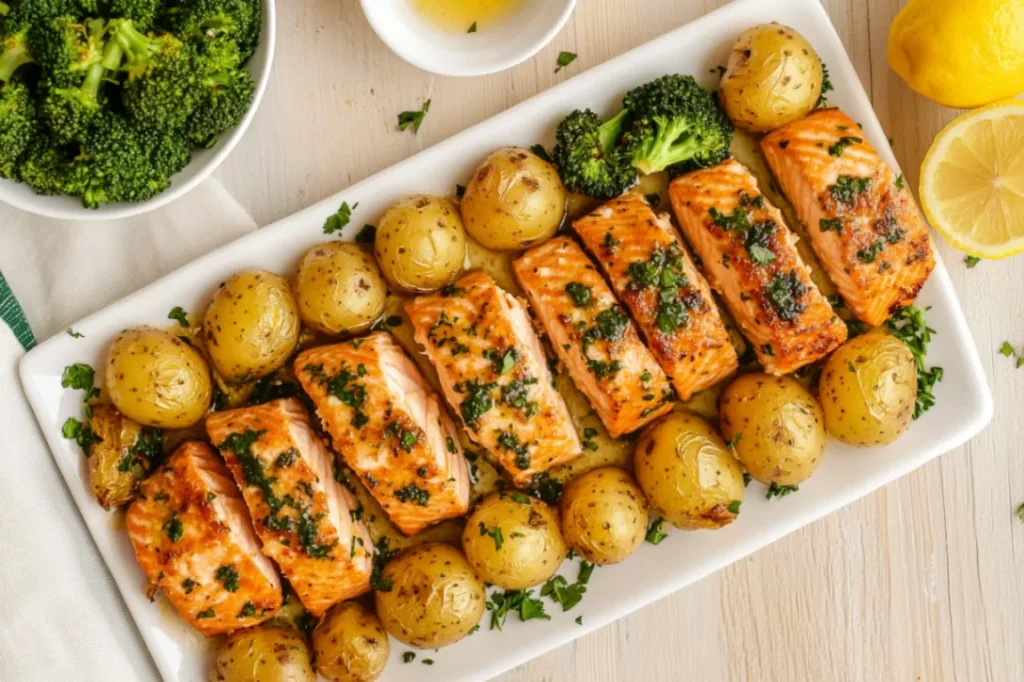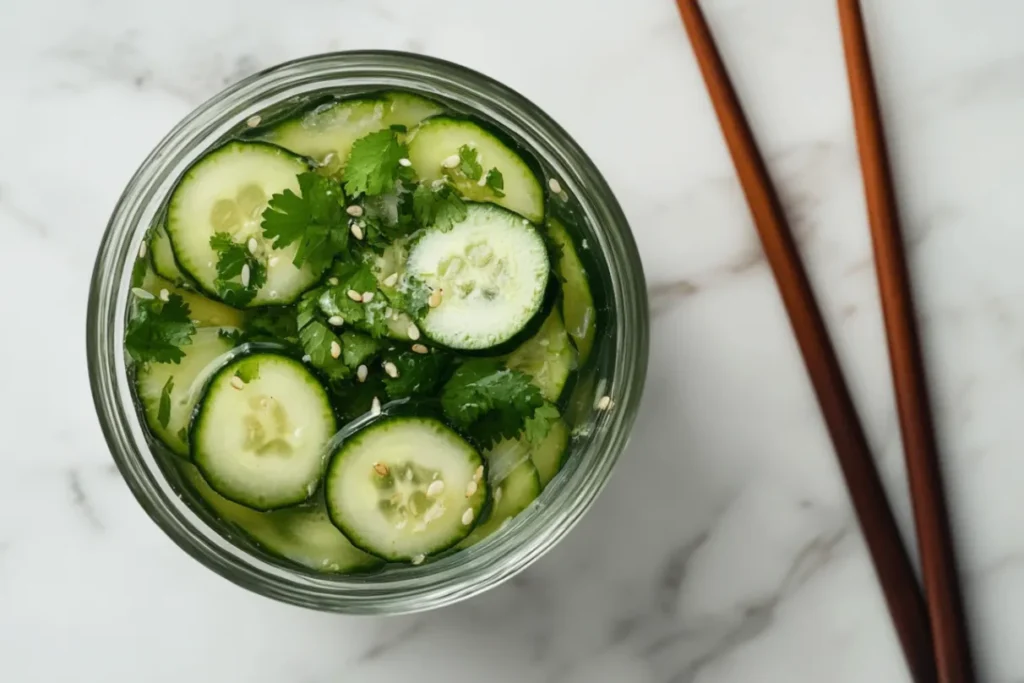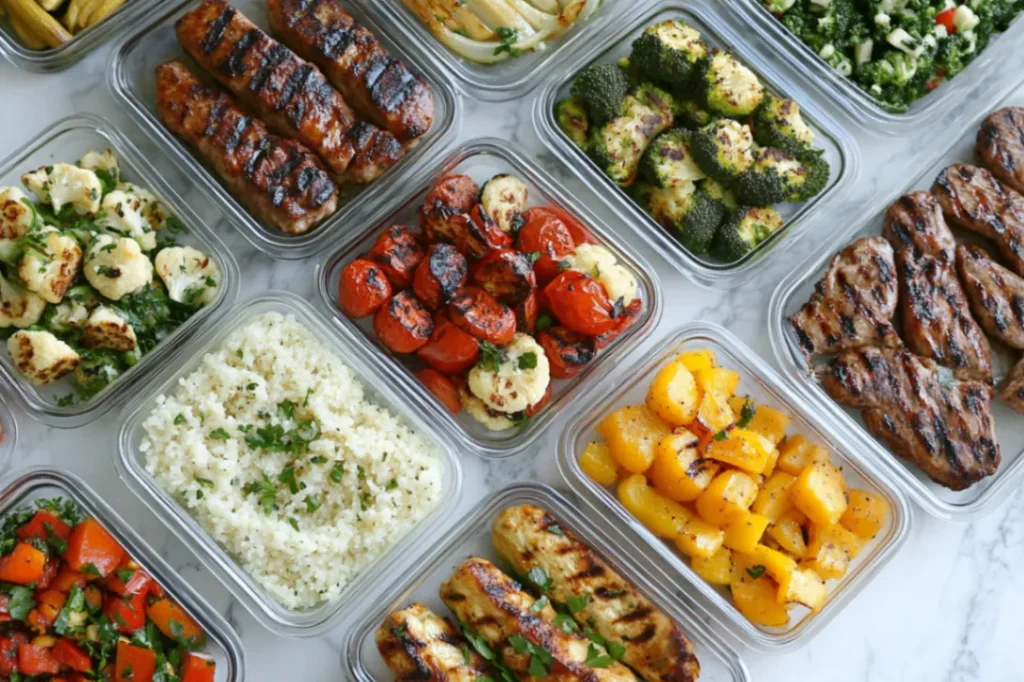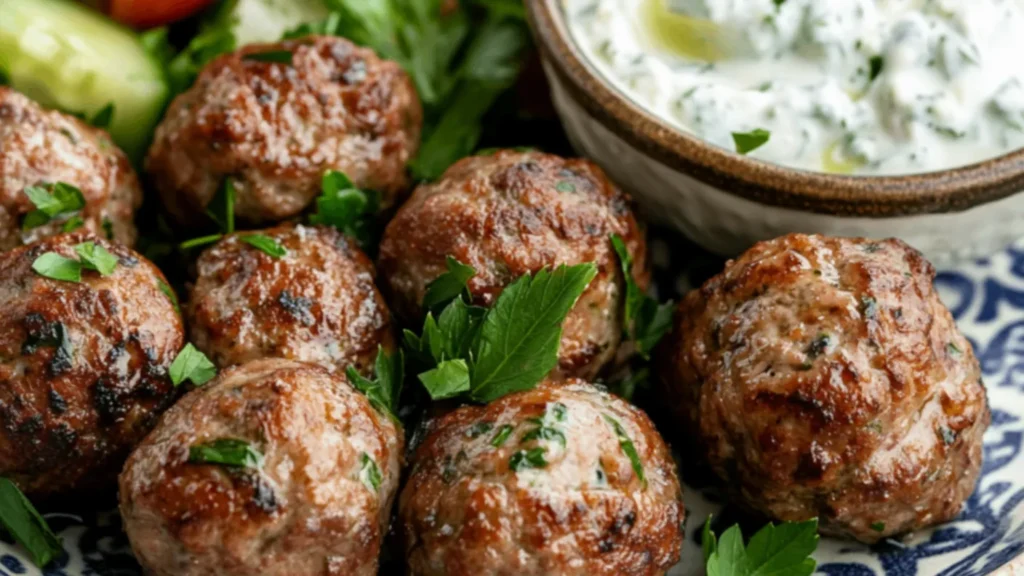
Table of Contents
Introduction
In today’s fast-paced world, finding nutritious meals that satisfy the entire family while supporting health goals can feel like an impossible challenge. Low carbohydrate eating has emerged as a sustainable approach for families looking to improve overall health, manage weight, and address specific health concerns. This comprehensive guide explores everything you need to know about creating delicious, satisfying low-carb family dinners that even the pickiest eaters will enjoy.
Low-carb eating isn’t about deprivation—it’s about making smarter food choices that fuel your body efficiently while reducing excess sugar and processed ingredients. Whether you’re looking to lose weight, manage blood sugar levels, increase energy, or simply adopt healthier eating habits as a family, low-carb dinners offer a versatile and delicious solution.
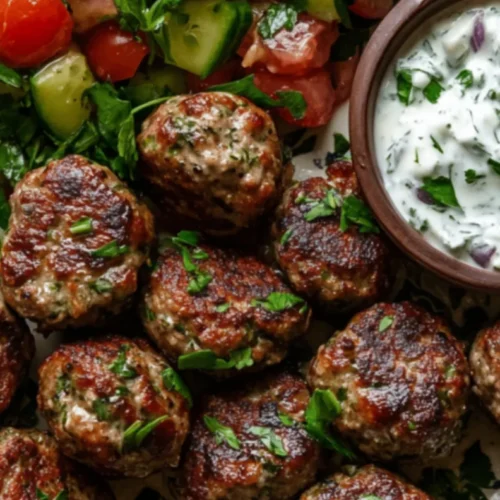
Low-Carb Herb Meatballs with Yogurt Sauce
Ingredients
- 500 g ground beef or lamb
- 2 cloves garlic minced
- 1 small red onion finely chopped
- 1/4 cup fresh parsley chopped
- 1 egg
- Salt and black pepper to taste
- 1 tbsp olive oil for frying
- 1 cup Greek yogurt
- 1 tbsp lemon juice
- 1/2 cucumber finely chopped
- 1 tbsp fresh dill or mint
- Mixed salad: cherry tomatoes cucumbers, parsley
What Makes a Meal “Low Carb”?
Before we dive into specific recipes and meal ideas, let’s clarify what exactly constitutes a “low-carb” meal. While definitions vary, most nutritionists classify low-carb eating as consuming fewer than 100-150 grams of carbohydrates per day. A typical low-carb dinner might contain approximately 15-30 grams of carbohydrates per serving.
Low-carb meals focus on:
- Protein sources (meat, poultry, fish, eggs)
- Healthy fats (avocados, olive oil, nuts)
- Non-starchy vegetables (leafy greens, broccoli, cauliflower)
- Limited amounts of lower-sugar fruits
- Minimal refined grains, sugars, and processed foods
The beauty of low-carb cooking lies in its flexibility—you can adjust carbohydrate levels to meet your family’s specific needs and preferences while still enjoying flavorful, satisfying meals together.
Benefits of Low-Carb Family Dinners
Switching to low-carb family dinners brings numerous advantages beyond just potential weight management:
1. Stabilized Energy Levels
By reducing blood sugar spikes and crashes, low-carb meals can help maintain consistent energy levels throughout the evening and into the next day. This is particularly beneficial for children who need sustained energy for homework, activities, and proper sleep.
2. Improved Focus and Mood
Many families report better concentration and more stable moods when reducing refined carbohydrates and sugars. This can translate to more pleasant family dinners and smoother evening routines.
3. Better Satiety and Reduced Snacking
Protein and healthy fats are incredibly filling, helping to reduce post-dinner snacking and nighttime hunger. This natural appetite regulation can support healthy eating patterns for the entire family.
4. Potential Health Benefits
Research suggests that moderating carbohydrate intake may support:
- Weight management
- Improved insulin sensitivity
- Reduced inflammation
- Better cardiovascular markers
- Potential benefits for certain neurological conditions
5. More Nutritious Food Choices
When you reduce processed carbohydrates, you naturally make room for more nutrient-dense foods like vegetables, quality proteins, and healthy fats—increasing your family’s overall nutrient intake.
Essential Ingredients for Low-Carb Family Meals
Creating a low-carb-friendly kitchen doesn’t require exotic ingredients or special products. Here are the staples you’ll want to keep on hand:
Protein Sources
- Chicken (breasts, thighs, whole)
- Beef (ground, steaks, roasts)
- Pork (tenderloin, chops)
- Fish and seafood (salmon, shrimp, white fish)
- Eggs
- Tofu and tempeh (for plant-based options)
- Ground turkey
- Lamb
Non-Starchy Vegetables
- Leafy greens (spinach, kale, lettuce)
- Cruciferous vegetables (broccoli, cauliflower, Brussels sprouts)
- Zucchini and summer squash
- Bell peppers
- Mushrooms
- Asparagus
- Green beans
- Cabbage
- Eggplant
- Tomatoes (technically a fruit but low in carbs)
Healthy Fats
- Olive oil
- Avocado and avocado oil
- Coconut oil
- Butter or ghee (if dairy is included)
- Nuts and seeds (almonds, walnuts, chia seeds, flaxseeds)
- Full-fat dairy products (cheese, Greek yogurt)
Low-Carb Pantry Items
- Almond flour and coconut flour
- Herbs and spices
- Bone broth
- Canned tomatoes
- Olives
- Pickles
- Sugar-free condiments
- Unsweetened almond or coconut milk
Limited Carbohydrates
- Small portions of berries
- Limited amounts of sweet potatoes or winter squash
- Small servings of beans or lentils (higher in carbs but nutrient-dense)
- Occasional small portions of whole grains for family members with higher carb needs
10 Family-Friendly Low-Carb Dinner Recipes
Let’s explore ten delicious low-carb dinner recipes that the whole family will love. Each recipe is designed to be nutritious, satisfying, and adaptable to different taste preferences.
1. Sheet Pan Garlic Butter Chicken with Roasted Vegetables
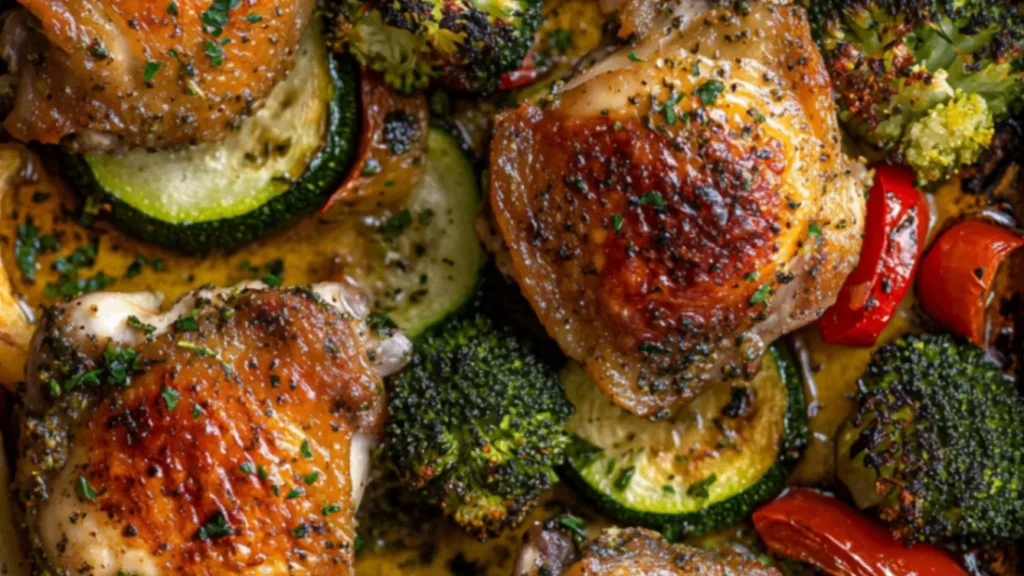
Ingredients:
- 2 pounds chicken thighs (bone-in, skin-on)
- 4 tablespoons butter, melted
- 4 cloves garlic, minced
- 1 tablespoon fresh rosemary, chopped
- 1 tablespoon fresh thyme, chopped
- 1 medium head broccoli, cut into florets
- 2 bell peppers, sliced
- 1 medium zucchini, sliced
- 1 red onion, cut into wedges
- 2 tablespoons olive oil
- Salt and pepper to taste
Instructions:
- Preheat oven to 425°F (220°C).
- In a small bowl, mix melted butter, minced garlic, rosemary, thyme, salt, and pepper.
- Place chicken thighs on one side of a large baking sheet.
- In a large bowl, toss vegetables with olive oil, salt, and pepper, then arrange on the other side of the baking sheet.
- Brush chicken with the garlic butter mixture.
- Roast for 30-35 minutes until chicken reaches 165°F (74°C) internal temperature and vegetables are tender.
- For extra crispiness, broil for 2-3 minutes at the end.
Nutrition per serving (serves 4): 410 calories, 28g fat, 7g carbs, 2g fiber, 35g protein
2. Taco-Stuffed Bell Peppers
Ingredients:
- 6 large bell peppers, tops removed and seeded
- 1.5 pounds ground beef
- 1 small onion, diced
- 3 cloves garlic, minced
- 2 tablespoons taco seasoning (homemade or low-carb store-bought)
- 1 can (14 oz) diced tomatoes, drained
- 1 cup shredded cheddar cheese
- Optional toppings: sour cream, diced avocado, sliced green onions, chopped cilantro
Instructions:
- Preheat oven to 375°F (190°C).
- Place hollowed bell peppers in a baking dish.
- In a large skillet over medium heat, brown the ground beef with onions until no longer pink.
- Add garlic and cook for 1 minute until fragrant.
- Stir in taco seasoning and diced tomatoes. Simmer for 5 minutes.
- Fill each pepper with the meat mixture and top with shredded cheese.
- Cover with foil and bake for 25 minutes.
- Remove foil and bake for another 5-10 minutes until peppers are tender and cheese is bubbly.
- Serve with optional toppings.
Nutrition per serving (serves 6): 320 calories, 21g fat, 9g carbs, 3g fiber, 25g protein
3. Creamy Tuscan Garlic Salmon
Ingredients:
- 4 salmon fillets (6 oz each)
- 2 tablespoons olive oil
- 3 cloves garlic, minced
- 1 cup heavy cream
- 1/2 cup chicken broth
- 1 cup spinach, packed
- 1/2 cup sun-dried tomatoes, chopped
- 1/2 cup grated Parmesan cheese
- 1 teaspoon Italian seasoning
- Salt and pepper to taste
- Fresh basil for garnish
Instructions:
- Season salmon fillets with salt and pepper.
- Heat olive oil in a large skillet over medium-high heat.
- Sear salmon, skin side up, for 4-5 minutes, then flip and cook for another 2 minutes. Remove and set aside.
- In the same skillet, add minced garlic and cook for 30 seconds until fragrant.
- Add chicken broth, heavy cream, and Italian seasoning. Bring to a simmer.
- Stir in Parmesan cheese until melted and smooth.
- Add spinach and sun-dried tomatoes, cooking until spinach wilts.
- Return salmon to the skillet and spoon sauce over the fillets.
- Simmer for 2-3 minutes until salmon is cooked through.
- Garnish with fresh basil before serving.
Nutrition per serving (serves 4): 520 calories, 42g fat, 5g carbs, 1g fiber, 32g protein
4. Cauliflower Crust Pizza with Fresh Toppings

Ingredients for Crust:
- 1 medium head cauliflower, riced (about 4 cups)
- 2 large eggs, beaten
- 1/3 cup shredded mozzarella cheese
- 1/4 cup grated Parmesan cheese
- 1 teaspoon Italian seasoning
- 1/2 teaspoon garlic powder
- Salt and pepper to taste
Ingredients for Toppings:
- 1/2 cup low-carb pizza sauce
- 1.5 cups shredded mozzarella cheese
- 1/4 cup sliced bell peppers
- 1/4 cup sliced mushrooms
- 1/4 cup sliced olives
- 1/4 cup diced red onion
- 2 tablespoons fresh basil, chopped
- Optional protein: pepperoni, cooked Italian sausage, or grilled chicken
Instructions:
- Preheat oven to 425°F (220°C) and line a baking sheet with parchment paper.
- Rice cauliflower in a food processor, then microwave for 5 minutes. Let cool completely.
- Place cooled cauliflower in a clean kitchen towel and squeeze out excess moisture.
- In a bowl, combine dried cauliflower with eggs, cheeses, and seasonings.
- Press mixture onto the parchment paper in a circular shape, about 1/4 inch thick.
- Bake for 15-20 minutes until golden brown.
- Remove from oven, add sauce and toppings, then return to oven for 10 minutes until cheese is bubbly.
- Garnish with fresh basil before serving.
Nutrition per serving (serves 4): 265 calories, 18g fat, 9g carbs, 3g fiber, 19g protein
5. Zucchini Noodles with Creamy Garlic Shrimp

Ingredients:
- 4 large zucchini, spiralized
- 1 pound large shrimp, peeled and deveined
- 2 tablespoons olive oil
- 4 cloves garlic, minced
- 1/4 teaspoon red pepper flakes (optional)
- 1/2 cup chicken broth
- 1/2 cup heavy cream
- 1/4 cup grated Parmesan cheese
- 2 tablespoons fresh lemon juice
- 2 tablespoons fresh parsley, chopped
- Salt and pepper to taste
Instructions:
- Season shrimp with salt and pepper.
- Heat 1 tablespoon olive oil in a large skillet over medium-high heat.
- Cook shrimp for 1-2 minutes per side until pink and opaque. Remove and set aside.
- In the same skillet, add remaining olive oil and minced garlic. Cook for 30 seconds.
- Add red pepper flakes and chicken broth, simmer for 2 minutes.
- Stir in heavy cream and bring to a gentle simmer.
- Add Parmesan cheese and stir until melted and sauce thickens slightly.
- Add zucchini noodles and toss for 2-3 minutes until just tender but still firm.
- Return shrimp to the skillet and add lemon juice.
- Toss to combine and heat through.
- Garnish with fresh parsley before serving.
Nutrition per serving (serves 4): 310 calories, 22g fat, 8g carbs, 2g fiber, 24g protein
6. Greek-Style Lamb Meatballs with Tzatziki Sauce
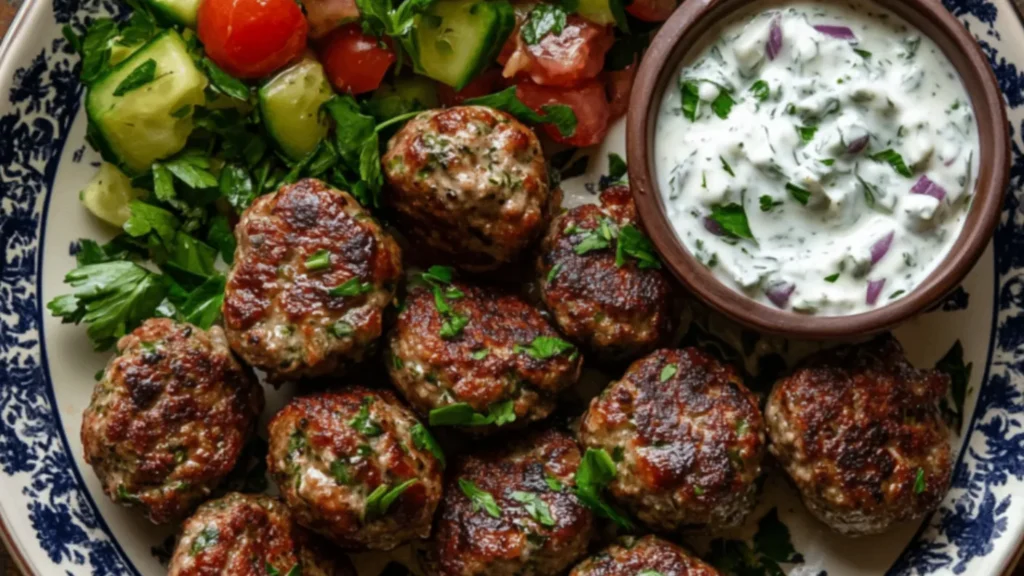
Ingredients for Meatballs:
- 1.5 pounds ground lamb
- 1/4 cup almond flour
- 1 large egg
- 3 cloves garlic, minced
- 1 tablespoon fresh mint, chopped
- 1 tablespoon fresh oregano, chopped
- 1 teaspoon ground cumin
- 1 teaspoon lemon zest
- 1/2 cup crumbled feta cheese
- Salt and pepper to taste
Ingredients for Tzatziki Sauce:
- 1 cup Greek yogurt (full-fat)
- 1/2 cucumber, grated and squeezed dry
- 2 cloves garlic, minced
- 1 tablespoon olive oil
- 1 tablespoon fresh dill, chopped
- 1 tablespoon fresh lemon juice
- Salt and pepper to taste
Ingredients for Greek Salad:
- 1 cucumber, chopped
- 1 bell pepper, chopped
- 1 cup cherry tomatoes, halved
- 1/4 red onion, thinly sliced
- 1/2 cup Kalamata olives
- 1/4 cup feta cheese, crumbled
- 2 tablespoons olive oil
- 1 tablespoon red wine vinegar
- 1 teaspoon dried oregano
- Salt and pepper to taste
Instructions:
- Preheat oven to 400°F (200°C) and line a baking sheet with parchment paper.
- In a large bowl, combine all meatball ingredients except the feta. Mix gently.
- Fold in feta cheese.
- Form mixture into 20-24 meatballs and place on prepared baking sheet.
- Bake for 18-20 minutes until cooked through.
- Meanwhile, combine all tzatziki ingredients in a bowl. Refrigerate until ready to serve.
- For the salad, combine all vegetables and feta in a bowl.
- In a small bowl, whisk together olive oil, vinegar, oregano, salt, and pepper.
- Pour dressing over salad and toss to combine.
- Serve meatballs with tzatziki sauce and Greek salad.
Nutrition per serving (serves 6): 485 calories, 38g fat, 8g carbs, 2g fiber, 28g protein
7. Beef and Broccoli Stir-Fry
Ingredients:
- 1.5 pounds flank steak, thinly sliced against the grain
- 2 tablespoons sesame oil, divided
- 4 cups broccoli florets
- 1 red bell pepper, sliced
- 3 cloves garlic, minced
- 1 tablespoon ginger, grated
- 1/4 cup beef broth
- 3 tablespoons tamari or coconut aminos (lower-carb soy sauce alternatives)
- 1 tablespoon rice vinegar
- 1 teaspoon fish sauce (optional)
- 1/2 teaspoon red pepper flakes (optional)
- 2 green onions, sliced
- 1 tablespoon sesame seeds
Instructions:
- In a small bowl, whisk together beef broth, tamari/coconut aminos, rice vinegar, and fish sauce if using. Set aside.
- Heat 1 tablespoon sesame oil in a large wok or skillet over high heat.
- Add beef in batches and stir-fry until browned, about 2-3 minutes per batch. Remove and set aside.
- Add remaining sesame oil to the wok.
- Add broccoli and bell pepper, stir-fry for 3 minutes.
- Add garlic and ginger, cook for 30 seconds until fragrant.
- Pour in sauce mixture and bring to a simmer.
- Return beef to the wok and toss to combine.
- Cook for another 1-2 minutes until everything is heated through.
- Sprinkle with green onions and sesame seeds before serving.
Nutrition per serving (serves 4): 390 calories, 24g fat, 10g carbs, 3g fiber, 36g protein
8. Buffalo Chicken Lettuce Wraps
Ingredients:
- 2 pounds boneless, skinless chicken thighs, cut into bite-sized pieces
- 2 tablespoons olive oil
- 2 cloves garlic, minced
- 1/2 cup buffalo sauce (check for low-carb options)
- 2 tablespoons butter
- 1 head butter lettuce or romaine hearts, leaves separated
- 1 cup celery, diced
- 1/2 cup red onion, finely diced
- 1/2 cup cherry tomatoes, quartered
- 1/4 cup blue cheese, crumbled (optional)
- 1/4 cup ranch dressing (use homemade or check store-bought for carb content)
- 2 tablespoons fresh cilantro, chopped
Instructions:
- Heat olive oil in a large skillet over medium-high heat.
- Add chicken pieces and cook until nearly done, about 7-8 minutes.
- Add minced garlic and cook for 30 seconds.
- Pour in buffalo sauce and add butter. Stir until butter melts and sauce coats chicken evenly.
- Simmer for 2-3 minutes until chicken is completely cooked through and sauce thickens slightly.
- Wash and dry lettuce leaves.
- To serve, fill lettuce leaves with buffalo chicken.
- Top with celery, red onion, cherry tomatoes, blue cheese if using, and a drizzle of ranch dressing.
- Garnish with fresh cilantro.
Nutrition per serving (serves 6): 340 calories, 22g fat, 5g carbs, 1g fiber, 29g protein
9. Eggplant Lasagna
Ingredients:
- 2 large eggplants, sliced lengthwise 1/4 inch thick
- 2 tablespoons olive oil
- 1 pound ground beef
- 1/2 pound Italian sausage, casings removed
- 1 onion, diced
- 3 cloves garlic, minced
- 1 can (28 oz) crushed tomatoes
- 2 tablespoons tomato paste
- 1 tablespoon Italian seasoning
- 2 cups ricotta cheese
- 1 large egg
- 1/4 cup fresh basil, chopped
- 2 cups shredded mozzarella cheese
- 1/2 cup grated Parmesan cheese
- Salt and pepper to taste
Instructions:
- Preheat oven to 375°F (190°C).
- Salt eggplant slices and let sit for 15 minutes to draw out moisture. Pat dry.
- Brush eggplant with olive oil and arrange on baking sheets.
- Roast for 15-20 minutes until slightly softened. Set aside.
- In a large skillet, brown ground beef and Italian sausage over medium heat.
- Add onion and cook until softened, about 5 minutes.
- Add garlic and cook for 30 seconds.
- Stir in crushed tomatoes, tomato paste, Italian seasoning, salt, and pepper.
- Simmer for 10 minutes, then remove from heat.
- In a bowl, mix ricotta cheese, egg, half the basil, salt, and pepper.
- In a 9×13 inch baking dish, spread a thin layer of meat sauce.
- Layer with eggplant slices, ricotta mixture, meat sauce, and mozzarella. Repeat layers.
- Top with remaining mozzarella and Parmesan cheese.
- Cover with foil and bake for 25 minutes.
- Remove foil and bake for another 20-25 minutes until bubbly and golden.
- Let rest for 10 minutes before serving.
- Garnish with remaining fresh basil.
Nutrition per serving (serves 8): 420 calories, 30g fat, 12g carbs, 4g fiber, 27g protein
Tips for Successful Low-Carb Family Dinners
Making the transition to low-carb family meals can be smooth and enjoyable with these practical tips:
Gradual Transition
Don’t shock your family system by eliminating all carbs overnight. Start by replacing one high-carb component with a low-carb alternative (like cauliflower rice instead of regular rice) while keeping the rest of the meal familiar.
Creative Substitutions
Learn to use low-carb alternatives to family favorites:
- Zucchini noodles or spaghetti squash instead of pasta
- Cauliflower rice instead of regular rice
- Lettuce wraps instead of tortillas or bread
- Portobello mushroom caps instead of burger buns
- Almond or coconut flour instead of wheat flour
- Mashed cauliflower instead of mashed potatoes
Focus on Familiar Flavors
Use herbs, spices, and familiar seasonings to make low-carb dishes taste similar to family favorites. The right seasoning can make cauliflower rice taste just as satisfying as the real thing!
Include Options for Different Needs
If some family members have higher carbohydrate needs (like active teenagers or those not following a low-carb approach), consider preparing a simple carbohydrate side dish they can add to their plates while keeping the main dish low-carb for everyone.
Get Kids Involved
Children are more likely to enjoy meals they help prepare. Let them assist with age-appropriate tasks like washing vegetables, measuring ingredients, or assembling lettuce wraps.
Make It Visually Appealing
We eat with our eyes first! Use colorful vegetables, attractive plating, and garnishes to make low-carb meals look appetizing and exciting.
Plan and Prep Ahead
Weeknight success often depends on weekend preparation. Chop vegetables, pre-cook proteins, and prepare components that can be quickly assembled on busy evenings.
Addressing Common Challenges
Even the most committed families face obstacles when adopting new eating patterns. Here’s how to overcome common challenges:
Picky Eaters
- Start with familiar low-carb foods and gradually introduce new ones
- Create “build your own” meals where everyone chooses their toppings
- Use favorite sauces and seasonings to make new foods more appealing
- Involve children in meal planning and preparation
- Be patient and persistent—taste preferences can take time to develop
Budget Concerns
- Focus on seasonal vegetables, which are more affordable
- Buy meat in bulk when on sale and freeze portions
- Use less expensive proteins like eggs and chicken thighs
- Incorporate intermittent fasting or smaller portion sizes to reduce overall food costs
- Grow simple herbs and vegetables at home if possible
Time Constraints
- Invest in time-saving equipment like slow cookers or pressure cookers
- Practice batch cooking on weekends
- Create a rotation of simple, quick-to-prepare meals for busy nights
- Prepare “dump and go” freezer meals in advance
- Keep ingredients for 2-3 emergency low-carb meals always on hand
Social Situations
- Eat something small before attending events where high-carb foods will be served
- Bring a low-carb dish to share at gatherings
- Focus on the social aspect rather than the food
- Look for low-carb options at restaurants and parties (meat, cheese, vegetables)
- Plan for strategic “carb cycling” around special events if appropriate for your family
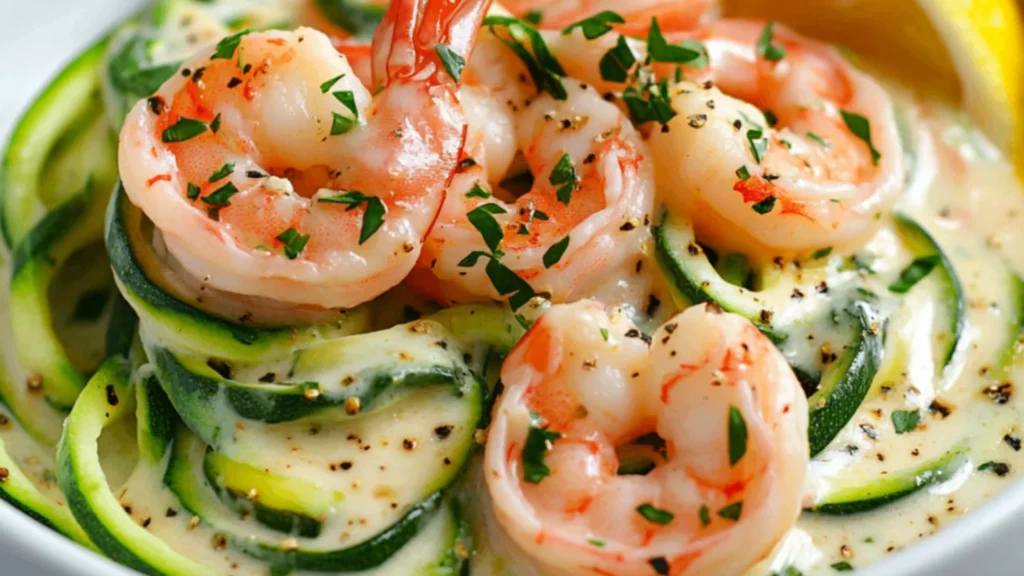
Low-Carb Meal Planning for Families
Effective meal planning is the cornerstone of successful family nutrition. Here’s a simple system for low-carb family meal planning:
Step 1: Create a Master Recipe List
Compile a collection of 15-20 low-carb recipes your family enjoys. Categorize them by:
- Quick weeknight meals (under 30 minutes)
- Make-ahead options
- Family favorites
- Special occasion dishes
Step 2: Schedule a Weekly Planning Session
Dedicate 15-30 minutes each week to plan the upcoming meals. Consider:
- Family schedule and activities
- Seasonal produce availability
- Sales and budget considerations
- Leftovers strategy
Step 3: Build a Flexible Weekly Template
Many families find success with a theme-based approach:
- Meatless Monday (vegetarian low-carb)
- Taco Tuesday (using lettuce wraps or low-carb tortillas)
- Slow Cooker Wednesday
- Breakfast-for-Dinner Thursday
- Pizza Night Friday (using cauliflower crust)
- Family Choice Saturday
- Roast or Batch Cook Sunday
Step 4: Create a Shopping List
Organize your shopping list by store sections:
- Produce
- Meat/Seafood
- Dairy
- Pantry Items
- Frozen Foods
Step 5: Implement a Prep Day
Dedicate 1-2 hours on a weekend day to:
- Wash and chop vegetables
- Cook proteins that can be repurposed
- Prepare marinades and sauces
- Make grab-and-go snacks
Low-Carb Food Storage and Meal Prep Tips
Maximizing the shelf life of low-carb ingredients helps reduce waste and ensure you always have healthy options available:
Fresh Vegetables
- Store in proper humidity conditions (crisper drawer)
- Use breathable produce bags
- Don’t wash until ready to use (except for greens for immediate consumption)
- Keep onions, garlic, and potatoes in cool, dark places (not refrigerated)
Proteins
- Freeze portions in meal-sized quantities
- Marinate before freezing to save time later
- Use vacuum sealing for longer freezer life
- Label with contents and date
- Thaw proteins in the refrigerator, not at room temperature
Prepared Foods
- Store in glass containers when possible (better for reheating)
- Cool completely before refrigerating
- Use leftovers within 3-4 days
- Freeze individual portions for easy lunches
- Label everything with contents and date
Troubleshooting Common Low-Carb Issues
Even experienced low-carb families occasionally encounter challenges. Here are solutions to common problems:
“I’m still hungry after meals”
- Increase protein and healthy fat content
- Add volume with non-starchy vegetables
- Ensure adequate hydration (thirst can masquerade as hunger)
- Check portion sizes—some family members may need larger servings
- Consider timing of meals and spacing throughout day
“We miss our high-carb favorites”
- Look for low-carb versions of favorite recipes
- Schedule occasional planned higher-carb meals
- Focus on what you’re adding, not what you’re removing
- Experiment with new flavor profiles and cuisines
- Create new family favorites to replace old standbys
“We’re getting bored with the same foods”
- Try one new recipe each week
- Explore international cuisines that are naturally lower in carbs
- Experiment with new herbs and spices
- Join online communities for fresh ideas
- Invest in a new low-carb cookbook for inspiration
“Low-carb eating is increasing our grocery bill”
- Focus on less expensive protein sources (eggs, chicken thighs, ground meat)
- Buy in bulk and freeze
- Shop seasonal produce or frozen vegetables
- Use cheaper cuts of meat in slow cooker recipes
- Reduce or eliminate low-carb specialty products
 DINNER
DINNER LUNCH
LUNCH CAKE
CAKE BREAKFAST
BREAKFASTFor more amazing recipes, be sure to check out our other sections to explore a variety of ideas that will enrich your cooking experience. Each section offers its own unique flavors to ensure a delightful culinary journey:
- Easy and Quick Recipes: A collection of dishes that guarantee delicious meals with minimal effort and time.
- Healthy Recipes: Discover healthy and delicious options that fit your lifestyle.
- Desserts: A diverse selection of sweets that will add a special touch of sweetness to your table.
- Lunch Recipes: Tasty lunch ideas that you can easily prepare to delight your family.
- Dinner Recipes: Delicious and easy-to-make recipes that will make your dinner a memorable occasion.
Conclusion
Low-carb family dinners represent more than just a dietary choice—they’re an investment in your family’s health and wellbeing. By focusing on whole, nutrient-dense foods while reducing refined carbohydrates and sugars, you’re teaching your children valuable lessons about nutrition that can serve them throughout their lives.
Remember that transitioning to low-carb eating is a journey, not a destination. Be patient with yourself and your family as you explore new flavors, recipes, and cooking techniques. Celebrate small victories, be flexible when needed, and focus on progress rather than perfection.
With the recipes, tips, and strategies in this guide, you have everything you need to create delicious, satisfying low-carb dinners that will nourish your family’s bodies and bring everyone together around the table. Here’s to your family’s health and happiness!
FAQ: Low-Carb Family Dinners
Q: Will my children get enough nutrients on a low-carb diet?
A: Absolutely. A well-planned low-carb diet includes plenty of vegetables, quality proteins, and healthy fats, providing essential nutrients that can sometimes be lacking in standard high-carbohydrate diets. Focus on nutrient-dense foods rather than just carb counting, and ensure children get adequate calories for their growth and activity levels.
Q: How strict should we be about carbohydrate limits for growing children?
A: Children generally have higher energy needs than adults, particularly during growth spurts and when physically active. Most health professionals recommend a moderate low-carb approach for children, focusing on eliminating processed foods and sugars while including healthy, whole-food carbohydrates like fruits, starchy vegetables, and occasionally whole grains in appropriate portions.
Q: Can athletes in the family follow a low-carb diet?
A: Yes, but modifications may be necessary. Active family members, especially those engaged in high-intensity sports, might benefit from strategic carbohydrate timing around workouts or slightly higher carb intake overall. Many athletes successfully follow a targeted low-carb approach, consuming carbs primarily around exercise periods while maintaining lower carb intake at other times.
Q: How do I handle school lunches on a low-carb plan?
A: Pack lunches whenever possible using dinner leftovers, low-carb wraps, or bento-style containers with protein, vegetables, and healthy fats. Teach children which cafeteria options align with family eating patterns, and consider a more flexible approach during school hours if necessary. Focus on stricter low-carb eating at home where you have more control.
Q: What about birthdays and special occasions?
A: Most low-carb families adopt a flexible approach to special occasions. Consider implementing the “90/10 rule” – follow your low-carb plan 90% of the time, allowing for planned exceptions during special celebrations. Another option is creating low-carb versions of celebration foods, such as almond flour cakes or crustless cheesecakes.
Q: How long does it take for children to adjust to low-carb eating?
A: Children often adapt more quickly than adults, typically within 2-4 weeks. The key is consistency and positive reinforcement. Avoid framing low-carb eating as restrictive; instead, focus on the delicious foods they CAN have. Taste preferences genuinely change over time, and foods that seemed bland initially often become favorites as palates adjust.
Low-Carb Snacks for Families
Keeping nutritious low-carb snacks available helps prevent reaching for high-carb convenience foods between meals. Here are some family-friendly options:
Protein-Based Snacks
- Hard-boiled eggs
- Turkey or beef jerky (check for added sugars)
- Lunch meat roll-ups with cheese
- Tuna salad on cucumber rounds
- Mini meatballs (can be served cold)
- Greek yogurt with berries (full-fat, unsweetened)
Vegetable-Based Snacks
- Bell pepper strips with guacamole
- Celery sticks with almond butter
- Cucumber slices with ranch dip
- Zucchini chips (baked or dehydrated)
- Cherry tomatoes with mozzarella
- Cauliflower hummus with veggie sticks
Nut and Seed Snacks
- Mixed nuts (portion-controlled)
- Pumpkin seeds (roasted)
- Almond flour crackers
- Flax seed crackers with cheese
- Chia seed pudding
- Coconut chips (unsweetened)
Sweet Treats (Low-Carb)
- Berries with whipped cream
- Chocolate fat bombs
- Avocado chocolate mousse
- Keto mug cake
- Strawberries dipped in melted dark chocolate
- Coconut milk ice cream (no sugar added)
The Impact of Low-Carb Eating on Family Health
Families who adopt low-carb eating patterns often report benefits that extend beyond weight management:
Physical Health Benefits
- Improved energy levels and reduced afternoon fatigue
- Better focus and concentration, particularly in children
- Reduced inflammation and associated symptoms
- Improved dental health with reduced sugar consumption
- More stable hunger patterns and fewer food cravings
- Better digestive health in many cases
Psychological Benefits
- Greater awareness of food choices and nutrition
- Improved relationship with food (focus on nourishment rather than restriction)
- Enhanced cooking skills and food appreciation
- Family bonding through meal preparation
- Pride in making healthy choices
Long-Term Health Education
Adopting a thoughtful low-carb approach teaches children valuable lifelong skills:
- How to read food labels and identify hidden sugars
- Understanding the difference between processed and whole foods
- Basic cooking techniques and meal preparation
- How food affects energy, mood, and wellbeing
- Making informed food choices outside the home
Adapting Family Favorites to Low-Carb Versions
You don’t have to abandon beloved family recipes when transitioning to low-carb eating. Here are strategies for adapting classic dishes:
Pasta Dishes
- Replace traditional pasta with zucchini noodles, spaghetti squash, or shirataki noodles
- Use thinly sliced cabbage in place of noodles in casseroles
- Try hearts of palm pasta for dishes like mac and cheese
- Make lasagna with thinly sliced zucchini or eggplant instead of pasta sheets
Rice-Based Dishes
- Substitute cauliflower rice in stir-fries, pilafs, and burrito bowls
- Use riced broccoli as an alternative base
- Try konjac rice for neutral-flavored dishes
- Make “risotto” with finely diced cauliflower
Potato Substitutes
- Mashed cauliflower with butter and cream
- Turnip or rutabaga fries
- Roasted radishes as potato replacements in stews and roasts
- Jicama fries or home fries
- Celery root purée as a potato alternative
Bread Replacements
- Lettuce wraps for sandwiches and burgers
- Portobello mushroom caps as burger buns
- Cloud bread made with eggs and cream cheese
- Almond flour or coconut flour quick breads
- Cheese wraps for burritos and sandwich rolls
Dessert Makeovers
- Crustless cheesecake or pies
- Chocolate avocado pudding
- Whipped cream with berries
- Almond flour cookies and cakes
- Coconut flour mug cakes
- Sugar-free gelatin with whipped cream
Low-Carb for Special Dietary Needs
Low-carb eating can be adapted for family members with special dietary considerations:
Dairy-Free Low-Carb
- Use coconut cream instead of heavy cream
- Try nutritional yeast for cheese flavor
- Incorporate coconut yogurt instead of Greek yogurt
- Use coconut oil or olive oil instead of butter
- Choose dairy-free protein sources like eggs, meat, fish, and poultry
Vegetarian Low-Carb
- Focus on eggs and dairy for protein
- Include tofu, tempeh, and seitan (in moderation)
- Use nuts and seeds liberally
- Consider protein powders to supplement meals
- Include lower-carb legumes in measured amounts
- Ensure adequate fat intake for satiety
Food Allergies
- For nut allergies: Use seeds, coconut flour, or sunflower seed flour instead of almond flour
- For egg allergies: Try flax eggs (1 Tbsp ground flaxseed + 3 Tbsp water) in baking
- For fish allergies: Focus on other quality proteins like poultry, beef, and plant-based options
- For multiple allergies: Emphasize naturally low-carb whole foods without allergens
Seasonal Low-Carb Eating Guide
Adapting your low-carb meal plan to seasonal produce ensures maximum flavor, nutrition, and budget-friendliness:
Spring
- Focus on: Asparagus, spring greens, radishes, artichokes, mushrooms
- Seasonal recipes: Spring vegetable frittata, lamb with herb sauce, salmon with asparagus
Summer
- Focus on: Zucchini, bell peppers, tomatoes, berries, cucumbers
- Seasonal recipes: Grilled kebabs, chilled soups, stuffed peppers, berry-based desserts
Fall
- Focus on: Brussels sprouts, cauliflower, mushrooms, pumpkin (in moderation), broccoli
- Seasonal recipes: Roasted vegetable platters, hearty stews, stuffed mushrooms, pork tenderloin
Winter
- Focus on: Cabbage, turnips, rutabaga, celery root, kale
- Seasonal recipes: Slow cooker dishes, braised meats, warm spiced dishes, hearty soups
Building a Supportive Low-Carb Family Culture
The most successful low-carb families create a positive, supportive culture around their food choices:
Focus on Abundance, Not Restriction
Emphasize all the delicious foods you CAN eat rather than dwelling on what’s off-limits. Keep the language positive and centered on health benefits rather than rules or restrictions.
Create New Traditions
Establish family traditions that support your low-carb lifestyle:
- Sunday meal prep together
- Family taste tests of new recipes
- Children taking turns choosing weekly special dinner
- Low-carb baking projects on weekends
Educate Without Pressuring
Help children understand the “why” behind food choices in age-appropriate ways without creating anxiety around food. Focus on how foods make our bodies feel strong and energetic rather than good/bad food dichotomies.
Allow Flexibility
Every family needs room for flexibility. Consider approaches like:
- 80/20 rule (80% low-carb, 20% more flexible)
- Special occasion exceptions
- Individual modification based on activity levels and needs
- Modified low-carb approach for growing children
Final Thoughts
Transitioning your family to low-carb eating is much more than a dietary change—it’s an investment in lifelong health habits. By focusing on whole, nutrient-dense foods, engaging children in the process, and maintaining a positive approach, you create a foundation for healthy eating that can benefit your family for generations.
Remember that there’s no single “right way” to do low-carb family eating. Whether you choose a moderate approach with occasional higher-carb meals, a strict ketogenic diet for specific health needs, or something in between, the key is finding what works sustainably for your unique family situation.
With the recipes, tips, and strategies provided in this guide, you have everything you need to begin or enhance your family’s low-carb journey. Here’s to delicious meals, improved health, and happy family dinners around the table!


